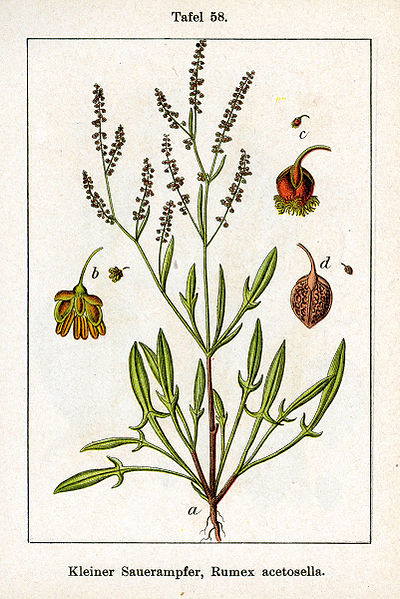Sheep Sorrel Rumex acetosella var. vulgaris
- Common Names
- Sheep Sorrel , Sheep or field sorrel, oseille
- Botanical Name
- Rumex acetosella var. vulgaris
- Syn. Acetosa acetosella
- Family
- PHYTOLACCACEAE
Medicinal Uses & Benefits of Sheep Sorrel
![]() How to Use|
Side Effects |
Plant & Garden|
How to Use|
Side Effects |
Plant & Garden|
- Medicinal Uses: * Cancer Prevention
* Kidney
- Properties: * Antiscorbutic * Depurative * Diaphoretic * Diuretic * Febrifuge * Refrigerant * Styptic
- Parts Used: Aerial parts
- Constituents: glycosides: hyperoside, quercetin-3d-galactoside, anthraquinones: emodin, aloe emodin, chrysophanol, rhein, physcion, vitamins: a, b complex, c, d, e, k, oxalates, tannins
How to Use: Sheep Sorrel
Preparation Methods & Dosage :Fresh leaves can be used as a garnish, in salads and soups. Herb powder is often encapsulated.The dried leaves be taken as a tea.
Sheep Sorrel Remedies
 In the Kitchen: The fresh leaves are edible
and can be enjoyed in salads and soups for their tart, lemony flavor.
In the Kitchen: The fresh leaves are edible
and can be enjoyed in salads and soups for their tart, lemony flavor.
Sheep Sorrel Side Effects: Not for long term use. Should be avoided by those with arthritis, gout or kidney stones because it contains oxalic acid.
Plant Description
- Flowers/Fruit/Seeds:Maroon-red,small, female flowers top the stems
- Plant Class: perennial, considered an invasive weed by most farmers
- Rhizome: vertical rootstock and/or creeping rhizomes
- Leaves:Green,glabrous, arrowhead-shaped leaves, reddish upright stems
- Preferred Habitat: Roadsides, cultivated fields, waste places, disturbed areas, lawns, meadows, railroad gravels, sandy and muddy shores: usually in acidic soils
- Flowering Season:Spring - Summer
- Distribution: presumably native to the southwestern Mediterranean region, including southwestern and Atlantic Europe, common in North America
How to Grow Sheep Sorrel
Most gardeners consider sorrel a perennial pesky weed. It is in good company, as many medicinal plants such as dandelion, plantain, and nettle are disdained as weeds to be rooted out of garden and lawn.
History and Traditions & Folklore
The whole herb is employed medicinally in the fresh state. The action is diuretic, refrigerant and diaphoretic, and the juice extracted from the fresh plant is of use in urinary and kidney diseases. 1 It is under the dominion of Venus. Sorrel is prevalent in all hot diseases, to cool any inflammation and heat of blood in agues pestilential or choleric, or sickness and fainting, arising from heat, and to refresh the overspent spirits with the violence of furious or fiery fits of agues; to quench thirst, and procure an appetite in fainting or decaying stomachs. For it resists the putrefaction of the blood, kills worms, and is a cordial to the heart, which the seed doth more effectually, being more drying and binding, and thereby stays the hot fluxes of women's courses, or of humours in the bloody flux, or flux of the stomach. The root also in a decoction, or in powder, is effectual for all the said purposes. Both roots and seeds, as well as the herb, are held powerful to resist the poison of the scorpion. The decoction of the roots is taken to help the jaundice, and to expel the gravel and the stone in the reins or kidneys. The decoction of the flowers made with wine and drank, helps the black jaundice, as also the inward ulcers of the body and bowels. A syrup made with the juice of Sorrel and fumitory, is a sovereign help to kill those sharp humours that cause the itch. The juice thereof, with a little vinegar, serves well to be used outwardly for the same cause, and is also profitable for tetters, ringworms, &c. It helps also to discuss the kernels in the throat; and the juice gargled in the mouth, helps the sores therein. The leaves wrapt in a colewort leaf and roasted in the embers, and applied to a hard imposthume, botch, boil, or plague sore, doth both ripen and break it. The distilled water of the herb is of much good use for all the purposes aforesaid.
It is under the dominion of Venus. Sorrel is prevalent in all hot diseases, to cool any inflammation and heat of blood in agues pestilential or choleric, or sickness and fainting, arising from heat, and to refresh the overspent spirits with the violence of furious or fiery fits of agues; to quench thirst, and procure an appetite in fainting or decaying stomachs. For it resists the putrefaction of the blood, kills worms, and is a cordial to the heart, which the seed doth more effectually, being more drying and binding, and thereby stays the hot fluxes of women's courses, or of humours in the bloody flux, or flux of the stomach. The root also in a decoction, or in powder, is effectual for all the said purposes. Both roots and seeds, as well as the herb, are held powerful to resist the poison of the scorpion. The decoction of the roots is taken to help the jaundice, and to expel the gravel and the stone in the reins or kidneys. The decoction of the flowers made with wine and drank, helps the black jaundice, as also the inward ulcers of the body and bowels. A syrup made with the juice of Sorrel and fumitory, is a sovereign help to kill those sharp humours that cause the itch. The juice thereof, with a little vinegar, serves well to be used outwardly for the same cause, and is also profitable for tetters, ringworms, &c. It helps also to discuss the kernels in the throat; and the juice gargled in the mouth, helps the sores therein. The leaves wrapt in a colewort leaf and roasted in the embers, and applied to a hard imposthume, botch, boil, or plague sore, doth both ripen and break it. The distilled water of the herb is of much good use for all the purposes aforesaid.
Nicholas Culpeper, 1653













